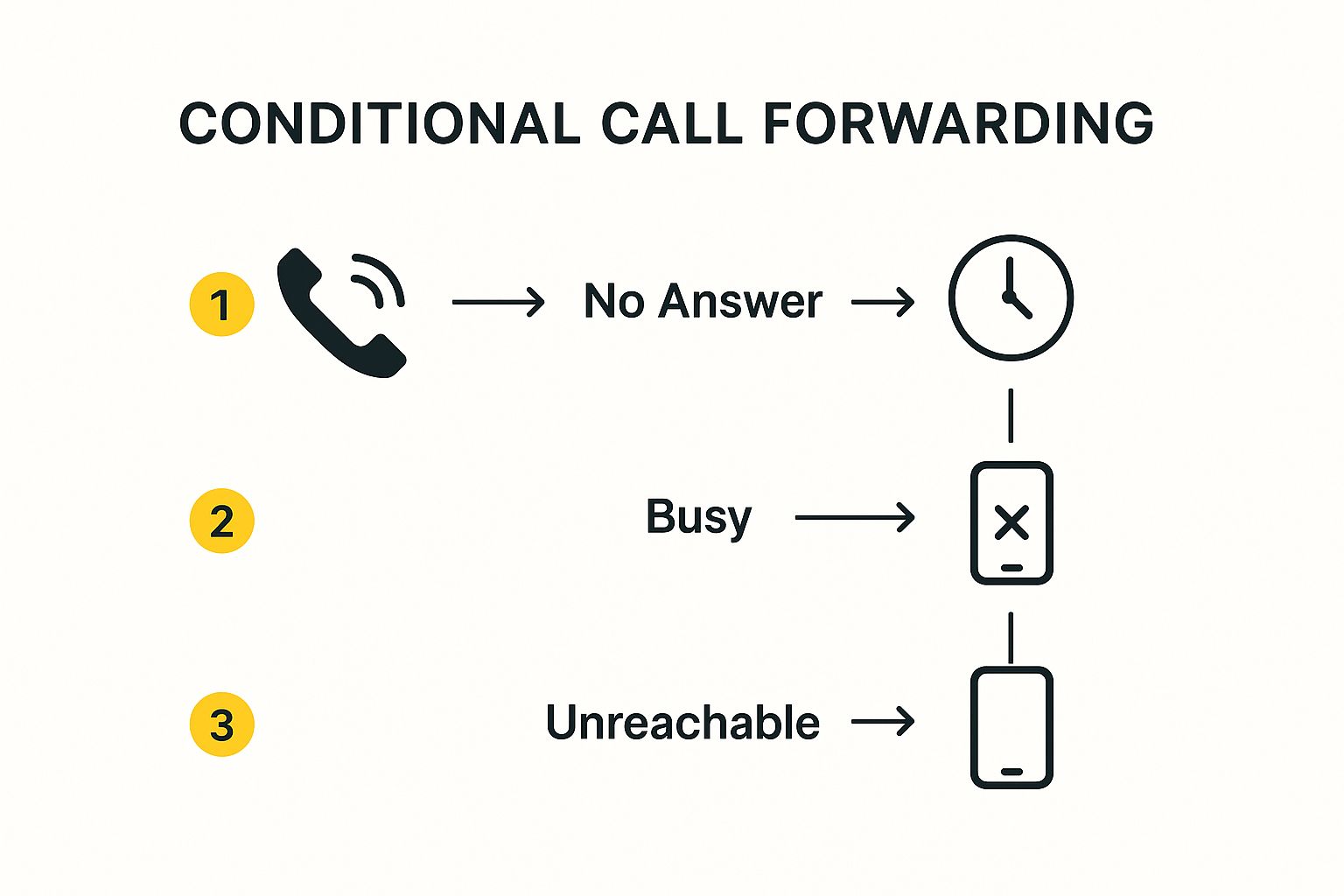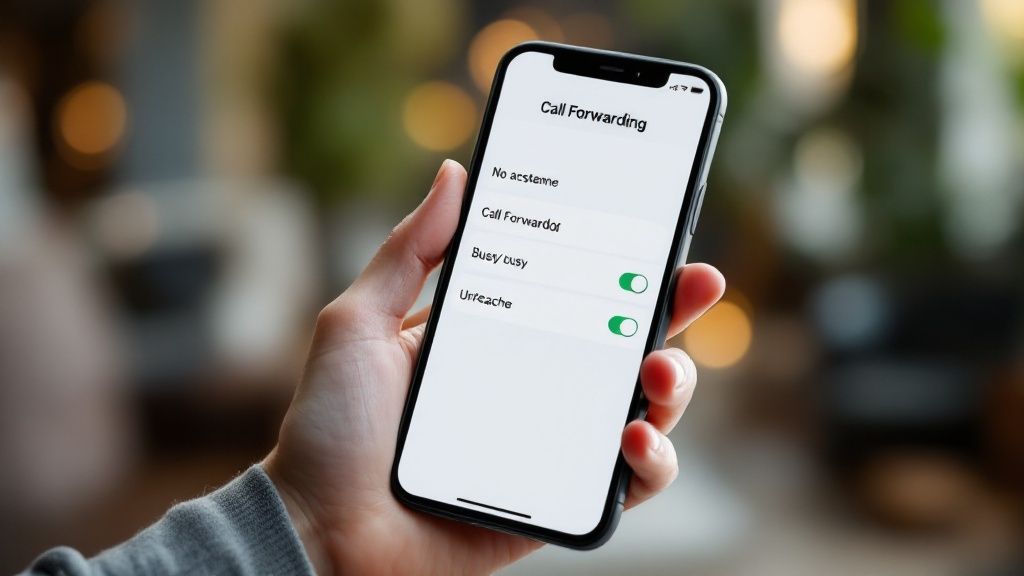The Power of Conditional Call Forwarding Explained

Conditional call forwarding is a smart system that routes calls based on pre-set rules. It's more sophisticated than simply redirecting every call. This intelligent call management offers a more personalized and efficient way to handle business communications. Think of it as a virtual receptionist, directing calls based on specific situations.
Understanding the Triggers
What kinds of "conditions" trigger call forwarding? Common triggers include a busy signal, an unanswered call, or an out-of-range device. Imagine you're already on a call; conditional forwarding seamlessly routes the incoming call to a colleague, voicemail, or another department. If you miss a call entirely, the system ensures the caller is connected with someone who can help. This responsiveness is vital for excellent customer service.
By 2024, Australian businesses are increasingly using conditional call forwarding to improve their communications. This feature efficiently manages customer interactions by redirecting calls only when certain conditions are met. These include situations like a busy line, an unanswered call, or an unreachable device. Want to learn more? Learn more about conditional call forwarding.
The Technology Behind Conditional Call Forwarding
Conditional call forwarding is integrated into Australia's telecommunications infrastructure. However, the specific technology may vary between carriers like Telstra and Optus. This means activation codes and setup processes can differ slightly. Understanding these differences is important for a smooth setup with your chosen provider.
Leveraging Conditional Forwarding for Enhanced Customer Experience
Businesses are using conditional call forwarding to improve customer experience. This ensures that customer calls are always handled, regardless of the time or method of contact. Routing after-hours calls to a dedicated team or messaging service maintains a professional image. It also makes the best use of internal resources, directing calls to the most suitable team member, even if the primary contact is unavailable. This flexibility is invaluable in today's dynamic business world.
Setting Up Conditional Call Forwarding Across Australian Networks

This infographic illustrates how conditional call forwarding works. It shows how different scenarios, like a busy line, no answer, or an unreachable phone, can direct calls to different destinations. This dynamic approach makes sure calls are always handled efficiently, which keeps your customers happy and your business responsive.
This guide provides practical steps for setting up conditional call forwarding on major Australian networks, including Telstra, Optus, and Vodafone. We'll walk you through the process so you can use this feature right away.
Activation Codes and Setup Procedures
Each carrier has its own set of codes and steps for setting up call forwarding. Knowing these specifics is key for a hassle-free setup. Telstra, for instance, typically uses specific codes followed by the forwarding number. Optus and Vodafone have similar setups, but the codes may vary. It's always best to check your carrier's website or call their customer support for the most accurate information.
Here's a general overview of how to set up conditional call forwarding. Remember to double-check the specific codes with your provider:
- No Answer: Forward calls if you don't pick up after a set number of rings.
- Busy: Forward calls if you're already on another call.
- Unreachable: Forward calls if your phone is off or out of service range.
Testing and Troubleshooting
Once you've set up call forwarding, it's important to test it. Call your number from another phone and simulate the conditions you've configured. This confirms that your calls are routing correctly. If you run into problems, recheck the activation codes and the forwarding number. Businesses in Australia sometimes face specific challenges due to network coverage, especially in remote locations. If issues continue, contacting your carrier's support is generally the best way to resolve any technical difficulties.
Compatibility Considerations
Conditional call forwarding typically works across various devices, including mobile phones, VoIP systems, and landlines. However, there can be compatibility differences depending on your specific setup and carrier. For businesses using VoIP, it's vital to check compatibility with your VoIP provider. This helps avoid disruptions and ensures smooth integration with your current system. By following these setup steps and checking for compatibility, you can confidently implement conditional call forwarding across your Australian business.
Transforming Customer Experience With Strategic Forwarding

Conditional call forwarding is more than just a feature; it's a strategic tool for improving customer interactions. For Australian businesses, this means optimizing call handling to create seamless customer journeys and build stronger relationships. This section explores the practical applications and measurable benefits of strategically implemented conditional call forwarding.
Real-World Applications Across Australian Businesses
This intelligent routing system is proving invaluable across various sectors. Retail businesses, for example, can maintain consistent service during peak seasons by routing overflow calls to dedicated teams or after-hours support.
This prevents long wait times and ensures customers receive prompt assistance, even when call volumes are high. Professional service firms can use conditional call forwarding to direct client calls to the right specialist based on their needs. This personalized approach improves first-call resolutions and enhances client satisfaction.
This flexibility is especially helpful for small businesses. By strategically managing calls, they can project a larger, more established presence. Conditional call forwarding allows small businesses to handle calls professionally, even with limited resources. This ensures every customer interaction contributes to a positive brand image and enhances customer satisfaction by ensuring prompt answers, avoiding missed or delayed responses.
For instance, if an employee is unavailable, calls can be forwarded to a team member or a call center. This flexibility also supports remote work, which significantly increased in Australia, especially after 2020, aligning with broader workforce mobility trends. Explore this topic further.
Measurable Outcomes and Business Impact
The benefits of strategic call forwarding go beyond anecdotal evidence. Many Australian businesses are seeing quantifiable improvements in key performance indicators. Reduced abandonment rates are a direct result of minimizing wait times and ensuring calls are answered promptly.
Improved first-call resolutions lead to greater efficiency and reduced operational costs. Perhaps most importantly, enhanced customer satisfaction scores translate to stronger customer loyalty and positive word-of-mouth referrals.
To further illustrate the advantages, let's look at the key business benefits in more detail:
To further illustrate these advantages, the following table outlines the key benefits Australian businesses can achieve through the strategic implementation of conditional call forwarding.
| Benefit | Impact on Business | Implementation Complexity |
|---|---|---|
| Reduced Abandonment Rates | Fewer lost customers, increased potential revenue | Low |
| Improved First-Call Resolution | Increased efficiency, lower operational costs | Low to Medium |
| Enhanced Customer Satisfaction | Stronger customer loyalty, positive word-of-mouth referrals | Low to Medium |
| Increased Flexibility & Scalability | Better adaptation to changing business needs, improved responsiveness during peak times | Medium |
| Professional Image for Small Businesses | Perception of a larger, more established operation, enhanced credibility | Low |
As this table shows, conditional call forwarding offers several benefits with varying levels of implementation complexity. While some, like reduced abandonment rates, are relatively straightforward to achieve, others, like increased flexibility and scalability, may require more planning and integration with existing systems. However, the potential return on investment across all these areas makes conditional call forwarding a compelling strategy for businesses of all sizes.
Gaining a Competitive Advantage Through Intelligent Routing
In Australia's competitive business environment, exceptional customer service is paramount. Conditional call forwarding empowers businesses to tailor their communication strategies to meet specific operational needs and customer expectations.
By aligning call routing with business objectives, Australian companies are gaining a distinct competitive advantage. This intelligent approach to call management contributes to increased efficiency, improved customer loyalty, and ultimately, a stronger bottom line.
Inside Australia's Call Centers: Forwarding in Action
Australia's leading call centers use conditional call forwarding to provide excellent customer service. Companies like Probe CX and Datacom integrate this technology into their communication systems. This helps them manage high call volumes, distribute work across teams, and ensure consistent service quality, no matter the time of day. This proactive approach to call management helps maintain a positive brand image and happy customers.
Balancing Workloads and Managing Call Volume
Conditional call forwarding allows call centers to adapt to changing call volumes. During busy periods, calls are automatically routed to less busy teams or agents. This prevents long wait times and dropped calls. Efficiently distributing workloads helps maintain service levels and reduces customer frustration.
For example, if the technical support team is overwhelmed, conditional forwarding can redirect calls to a general customer service team. This flexibility is important for businesses operating across different time zones or with seasonal call volume changes.
The Impact on Performance Metrics
Using conditional call forwarding strategically directly affects key call center metrics. First-call resolution rates improve when calls go to the most qualified agent immediately. Average handling times are reduced by efficiently routing calls and avoiding unnecessary transfers. By providing prompt and effective service, customer satisfaction scores increase. These improvements lead to a better customer experience and a stronger company reputation. For Australian businesses wanting 24/7 customer support, an after-hours answering service might be a good option.
Industry Growth and Demand for Call Management
The Australian call center industry needs strong call management solutions. The industry is projected to reach $2.0 billion in revenue by 2025, growing at a 0.3% CAGR over the past five years. More detailed statistics are available. Despite some offshoring, demand for high-quality call management in Australia remains strong, showing the importance of technologies like conditional call forwarding. Investing in this technology shows a commitment to great customer service in the Australian market. This demand further highlights how crucial optimized call management is for success in Australian business.
Advanced Conditional Call Forwarding Strategies That Win

Going beyond the basics of conditional call forwarding unlocks a world of possibilities for exceptional customer service. It's about creating smart routing strategies that fit the specific needs of Australian businesses. Let's dive into how you can elevate your call forwarding game.
Intelligent Routing Based on Caller Profiles, Time Zones, and Expertise
Imagine a system that instantly recognizes a high-value client and connects them directly with their dedicated account manager. That's the potential of intelligent routing. By linking your conditional call forwarding with your CRM system, you can build dynamic routing rules based on a variety of factors:
-
Caller Profile: Pinpoint VIP customers, new leads, or specific customer groups and route them to specialized teams.
-
Time Zones: Make sure calls reach available agents, no matter where your customers or team members are located across Australia. This is especially important for businesses operating nationwide.
-
Departmental Expertise: Direct technical questions to tech support, sales inquiries to the sales department, and general questions to a general customer service team. This ensures efficient and effective call handling.
This personalized touch not only smooths out operations but also strengthens customer relationships by connecting callers with the right person every single time.
Using AI for Better Routing Decisions
Effective call forwarding is a critical part of call center operations, and strong call center agent training is a must. AI-powered routing takes intelligent call management even further. These systems analyze call data, spot trends, and constantly refine routing decisions. For instance, if certain words are often used in calls that need to be escalated, the AI can learn to automatically route similar calls to senior agents. This ensures complex issues are handled quickly and customers receive the best possible support.
Monitoring and Optimization: Your Keys to Success
Setting up a monitoring system is vital for getting the most out of your conditional call forwarding strategy. Tracking key performance indicators (KPIs) offers valuable insights into how well your system is working and where you can make improvements. Here are some important metrics to watch:
-
Call Abandonment Rate: A high abandonment rate might suggest that callers are waiting too long or are being routed incorrectly.
-
First Call Resolution Rate: This metric tracks how often customer issues are resolved on the first call, showing how efficient and effective your routing strategy is.
-
Customer Satisfaction Scores: Gathering feedback through surveys helps you understand how customers perceive your call handling process.
By constantly monitoring these metrics and adjusting as needed, you can keep your conditional call forwarding strategy aligned with your business objectives and customer expectations. This commitment to great customer service plays a huge role in the success of Australian call centers. For example, industry leaders like Probe CX, Datacom Australia Holdings, and Serco generate significant revenue—with Probe CX earning around $362.9 million in 2025—by prioritizing customer service where conditional call forwarding is key. Find more detailed statistics here. By using these advanced strategies, you can transform conditional call forwarding from a simple function into a powerful tool for strengthening customer relationships and achieving business success.
Overcoming Conditional Call Forwarding Challenges
Conditional call forwarding offers great flexibility for businesses, but it also presents some unique challenges. This section explores common hurdles Australian businesses face and offers practical solutions to keep your communication systems running smoothly.
Technical Challenges and Solutions
Forwarding loops are a common technical issue. This happens when a call bounces back and forth between numbers indefinitely. Imagine your mobile forwards to your landline, which then forwards back to your mobile – a frustrating, endless loop. The simple solution is to carefully review your forwarding settings on all devices. Ensure there are no circular forwarding paths.
Another potential issue is cross-carrier compatibility. Sometimes, forwarding between different carriers, like Telstra and Optus, can cause problems. This might lead to dropped calls or poor audio quality. Thoroughly test your forwarding setup after any changes, especially if you're forwarding between different networks. If problems persist, contact your carrier for support.
Finally, network reliability plays a role in successful conditional call forwarding. Inconsistent coverage, particularly in regional Australia, can disrupt call forwarding. Consider a cloud-based call management system. These services offer more robust forwarding, often independent of traditional carrier networks. A service like OnSilent can provide reliable call management and voicemail, a real benefit for busy professionals.
Operational Challenges and Best Practices
Maintaining a consistent customer experience is essential. Ensure forwarded calls are handled just as professionally as those answered directly. This requires effective staff training. Prepare your team to handle forwarded calls efficiently and deliver the same high-quality service, no matter how the call comes in.
Smooth transitions between forwarded calls are also critical. If a call needs to be transferred multiple times, make the process seamless for the customer. Provide context to the next team member to avoid repeated questions and frustration.
Here's a staff training checklist:
-
System Understanding: Train your team on the intricacies of conditional call forwarding, including triggers and destinations.
-
Consistent Greetings: Use a standard greeting regardless of how the call arrives to maintain professionalism and a unified brand voice.
-
Information Gathering: Teach staff to quickly and efficiently gather essential caller information for effective assistance and routing.
-
Transfer Procedures: Establish clear protocols for transferring calls, including sharing context with the receiving team member to minimize customer frustration.
Troubleshooting Your Conditional Call Forwarding Setup
This table outlines common problems and solutions:
| Problem | Possible Cause | Solution |
|---|---|---|
| Call Forwarding Not Working | Incorrect Activation Codes | Check your carrier's documentation for the correct codes. |
| Calls Going Straight to Voicemail | Incorrect Forwarding Number | Verify the forwarding number and make sure it's active. |
| Forwarding Loop | Circular Forwarding Path | Review and remove any circular forwarding routes in your settings. |
| Poor Audio Quality | Cross-Carrier Compatibility | Contact your carrier or explore alternative solutions. |
| Inconsistent Forwarding | Network Reliability | Test your network and consider cloud-based solutions like OnSilent. |
By proactively addressing these technical and operational challenges, you can fully utilize the advantages of conditional call forwarding. This ensures your business communications are efficient, professional, and customer-focused, building a positive brand image and improving your bottom line.
The Future of Conditional Call Forwarding for Business
Conditional call forwarding is a cornerstone for Australian businesses. However, the technology continues to evolve. This section explores exciting developments shaping the future of business communication in Australia and how these advancements will change how we connect with customers.
Cloud-Based Communication Platforms: Expanding the Possibilities
Cloud technology is reshaping business communications. Cloud-based platforms are improving conditional call forwarding with better integration and flexibility. Businesses are no longer tethered to physical hardware and can manage forwarding rules from anywhere with internet access. This enables faster adjustments and more dynamic routing strategies.
For example, a business can integrate its CRM system (Learn more about CRM) with its cloud-based phone system. This routes calls based on customer profiles or previous interactions. This level of personalization is vital for positive customer experiences and stronger relationships. Cloud-based solutions also offer greater scalability, letting businesses adjust their call handling as needed.
The Rise of Predictive Routing With Machine Learning
Imagine anticipating customer needs before they’re even voiced. That’s the potential of machine learning in call routing. AI algorithms analyze call data, identifying patterns and predicting caller intent. This enables proactive routing, connecting customers with the most suitable agent immediately.
This advanced routing minimizes wait times, improves first-call resolution rates, and creates a more efficient and satisfying customer experience. An AI could, for instance, learn that callers using specific keywords likely have complex technical issues. It would then automatically route those calls to a specialized technical support team, avoiding transfers and frustration.
Unified Communications: Seamless Customer Journeys Across Channels
Future communication isn't limited to voice. Unified communications platforms combine voice, text, and video into seamless customer experiences. This means conditional call forwarding isn’t just for phone calls anymore. Businesses can use intelligent routing across multiple channels, directing inquiries to the appropriate team or communication method.
For example, a customer might start with a website chat. If the inquiry needs more help, the system can seamlessly transfer the interaction to a voice call with the right specialist. This integrated approach improves customer satisfaction and ensures efficient handling of all interactions. Australian businesses find this cost-effective, reducing the need for extra staff just to answer calls. It contributes to operational resilience and positive customer experience, both crucial in competitive Australian sectors like retail, finance, and telecommunications. The direct impact on customer engagement has been significant, with higher customer retention and faster query resolution attributed to seamless call handling. Discover more insights about this here.
Let's explore the different technologies driving this change:
To understand the differences between these technologies, take a look at the table below:
Conditional Call Forwarding Technology Comparison
This table compares traditional call forwarding with emerging technologies in the Australian telecommunications market.
| Feature | Traditional Forwarding | Cloud-Based Forwarding | AI-Enhanced Forwarding |
|---|---|---|---|
| Setup | Requires physical hardware and on-site configuration | Simple online setup and management | Requires integration with AI and data analytics platforms |
| Flexibility | Limited routing options and changes require manual intervention | Flexible routing rules and easy adjustments via online portal | Dynamic routing based on real-time data and predictive analysis |
| Scalability | Difficult and costly to scale as business needs change | Easily scalable to accommodate growth and fluctuating call volumes | Highly scalable due to cloud-based infrastructure and AI capabilities |
| Integration | Limited integration with other business systems | Integrates with CRM, helpdesk, and other cloud applications | Seamless integration with various data sources and communication channels |
| Cost | Higher upfront costs for hardware and maintenance | Subscription-based pricing with predictable costs | Variable pricing depending on AI features and usage |
| Intelligence | Basic call forwarding based on predefined rules | Advanced call routing based on time of day, caller ID, etc. | Predictive routing based on caller behavior, intent, and historical data |
This table highlights the evolution of call forwarding technology. While traditional methods offer basic functionality, cloud-based and AI-enhanced solutions provide greater flexibility, scalability, and integration capabilities. The key difference lies in the level of intelligence: from predefined rules to predictive analysis.
Positioning Your Business for the Future of Communication
These advancements present tremendous opportunities for Australian businesses. By embracing cloud technology, AI-driven routing, and unified communications, you can create more efficient and personalized experiences for your customers. These technologies allow businesses to maintain a human touch while maximizing operational efficiency.
Ready to streamline your communications and improve your customer experience? Explore how OnSilent, the smart voicemail and call management solution, can help your business thrive. Visit OnSilent now!

